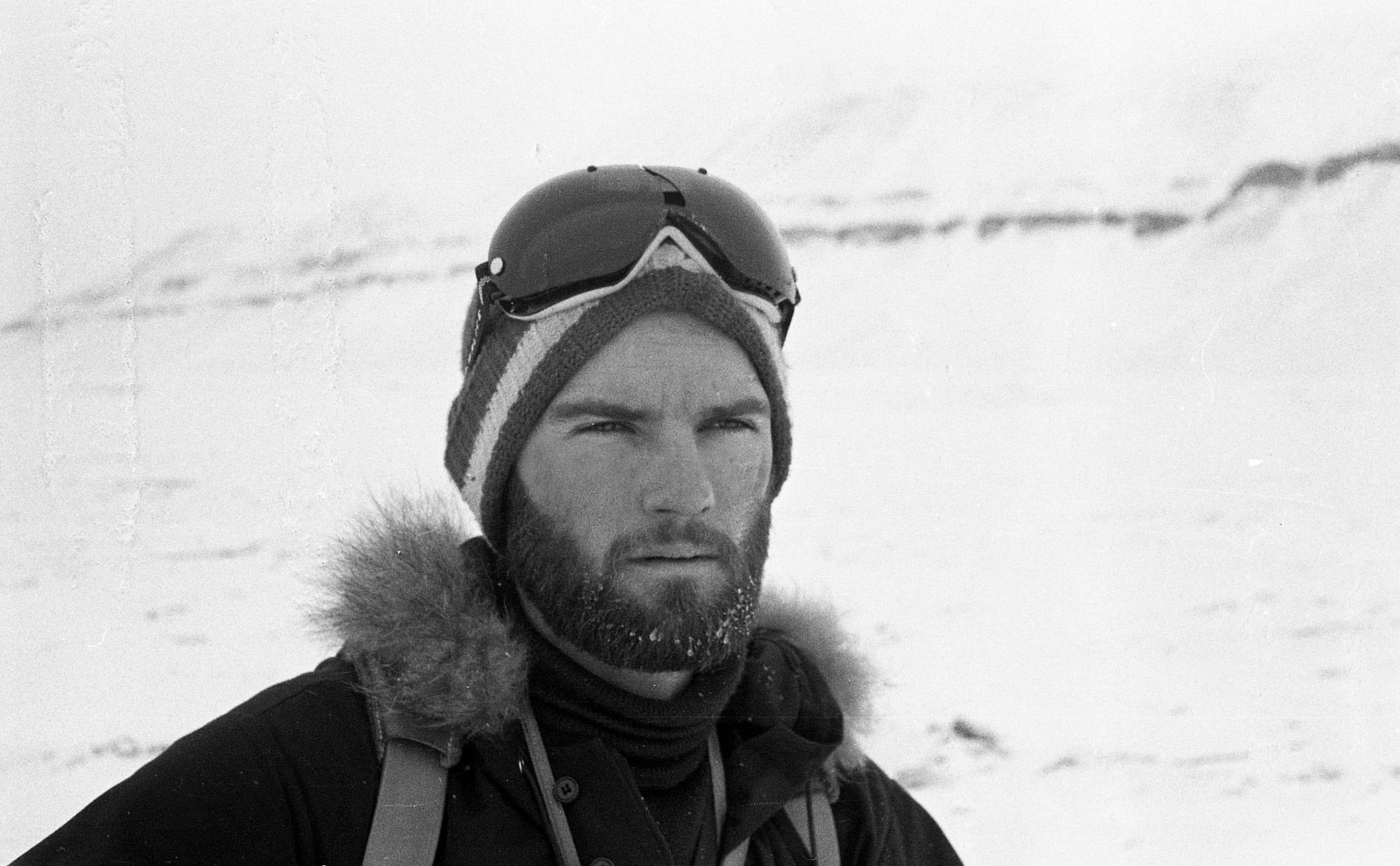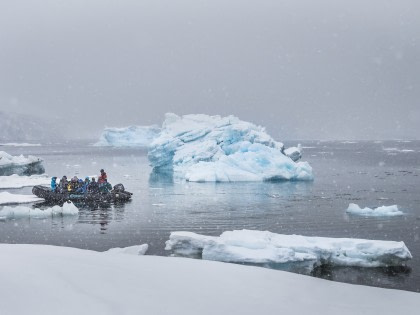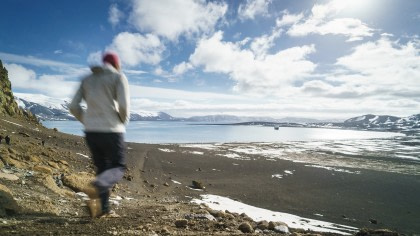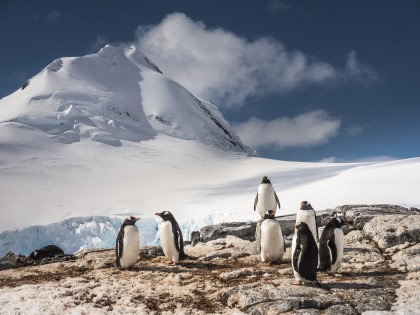From Norwegian hitchhiking to newbuild Hondius
In a few short weeks, Oceanwide Expeditions consultant Ko de Korte will join 174 passengers aboard the world’s first-registered Polar Class 6 vessel, Hondius, when it makes its maiden voyage to the Arctic island of Spitsbergen.
When Ko first set foot on the island, it was 1966 and Spitsbergen was known mostly to scientists and there was no such thing as an Iridium satellite phone.
“You often hear people say, ‘Those were different times,’” de Korte says with a sidelong smile. “But those were different times.”
We’re sitting in his spacious light-filled apartment, perched at the far end of a long pier overlooking the lapping gray waves of Amsterdam’s boxy, brick-lined waterfront. Books and records make up the surroundings as much as floors and furniture: texts on Kant, guides on the Galapagos, and table-sized atlases nest comfortably among an encyclopedic collection of blues LPs, many of which would be obscure to all but devout aficionados.
De Korte plays a few favorite tracks before we discuss the polar regions further, still very much in love with the music that inspired him to road-trip rural Mississippi in 1990, shooting an award-winning blues documentary about a vanishing American artform.
Though it’s tempting to talk as much about blues as we do about the polar cruise industry, eventually (but only after the last harmonica tapers off its steely, sonorous note) we dig into de Korte’s more than 50 years in polar travel, how it all started, and his take on its current state.

De Korte at Kapp Lee, 1968, photo by Eric Flipse
Early polar aspirations and expeditions
De Korte was born in 1943 in Meliskerke, a small Dutch village in Zeeland, the southwestern-most province of the Netherlands. “It’s a very open country. That’s probably why, for as long as I can remember, I’ve had a natural interest in wide-open spaces.”
As a boy he sought out stories on such famed polar explorers as Fridtjof Wedel-Jarlsberg Nansen, Sjef van Dongen, and the serialized accounts of Umberto Nobile’s Arctic airship expedition, supplementing them with the creative works of Jack London and Dutch poet Jan Jacob Slauerhoff.
Not surprisingly, these early interests led him to study biology at the Free University of Amsterdam, where his specialization in the animal geography of the Arctic resulted in friendships with several forerunning polar researchers of the day.
But it was not until 1965, when de Korte hitchhiked from the Netherlands to the Norwegian county of Finnmark, that he encountered some sense of the Arctic for himself. He spent the next few summers earning extra school money by working on a fishing boat in the Barents Sea, using his spare time to camp and visit the area’s large seabird colonies.
In 1966 he set foot in the Arctic proper for the first time, visiting Spitsbergen on a coal transport ship. Instantly hooked, de Korte did not return with the ship back to Norway, putting both his relationship and studies on hold to remain in Spitsbergen.
“I was alone a lot in those days,” he says, “but even when I’m alone in the polar regions, the loneliness I sometimes feel among other people can suddenly disappear.”
Eventually de Korte found other Arctic travelers with whom to share his outings. One of the highlights of these early adventures included overwintering in east Spitsbergen, during which he and his companions had very little contact with the outside world.
“I see this as one of the last classic polar expeditions,” he says. “It was before you had a lot of Arctic airfields and helicopter travel, and Iridium phones – these are the satellite phones that let you call from remote places like the Arctic – wouldn’t be invented for decades. So this really was polar overwintering in the traditional sense.”
Later expeditions, many of them with the purpose of studying skua populations, brought de Korte to such locations as Greenland, South Georgia, and the South Shetlands. And it was this extensive polar background that led to the next phase of his professional life.

Storfjorden, 1969
Formation of Plancius Foundation, later Oceanwide Expeditions
In 1975 the Dutch University of Groningen invited de Korte to become a member of their Arctic Centre, which was planning an archeological study in northwest Spitsbergen and needed an experienced polar researcher to help organize it.
What resulted was the Plancius Foundation. Starting in 1979, the foundation conducted some of the first Smeerenburg research expeditions in archeology, even acquiring an ice-class vessel for this purpose: m/v Plancius (not the same Plancius currently owned and operated by Oceanwide).
But when these studies concluded three years later, the foundation could not decide what to do with their ship. It dawned on de Korte, who had already studied the impact of tourism on breeding seabirds in the Galapagos, that Plancius could be used to bring everyday travelers to the Arctic during its scientific expeditions.
De Korte arranged many of these expeditions’ logistics himself, taking to his new role enthusiastically. “I really enjoyed seeing the pleasure tourists took at experiencing the landscape and wildlife of Spitsbergen. This new job was really just joining together two things that I knew, because to me Spitsbergen is the Galapagos of the Arctic.”
By 1983 the Plancius Foundation was regularly taking non-scientists to Spitsbergen, though by today’s standards these early cruises were none too cruise-like: Tourists were expected to peel their own potatoes, pack their own lunches, and above all not complain.
“We had a blacklist for the passengers who did complain,” de Korte says, his smile turning impish. “These people were not invited back.”
The outings also were different. Today the standard is two daily outings, each about three hours long, divided by a catered lunch aboard the ship. Back then, however, passengers left the ship in the early morning, ate lunch in the field, and didn’t return until about 5pm.
Also, there was no dedicated crew, as this was simply unaffordable. Rather, crew members were invited internship-style from local sailing schools, while captains consisted of volunteer pensioners with a background in polar sailing.
And though the Plancius Foundation could not venture into Antarctica until 1991, it did have success in places like Cape Verdes, the Caribbean, and the Orinoco River of Venezuela. This helped it stay afloat and also acquire an affordable replacement vessel, m/v Professor Molchanov, from Russian sellers after the collapse of the Soviet Union.
After several years of this, however, the naturally explorative de Korte was tiring of the routine. But around this time, as luck would have it, he met Albert Veldkamp, a Dutch captain who’d worked on Plancius, and Wijnand van Gessel, a Dutch businessman who owned an expedition travel company named Oceanwide Expeditions.
Van Gessel also owned a schooner, Rembrandt van Rijn, and had been chartering it out in Spitsbergen. After he began using the ship for his own tropical program in 1995, he and de Korte decided to work together.
A year later van Gessel purchased key elements of the Plancius Foundation, putting it under the flag of Oceanwide with the agreement that de Korte would work on a contractual basis as the company’s consultant. This is the function he still serves to this day.

Kapp Lee, 1969
Hondius and the new days of polar expedition cruise travel
On June 3, roughly a half century after his first Arctic voyage, de Korte will return to the island that started it all: Spitsbergen. But though he always loves seeing this iconic location again, a lot has changed since he first began working in polar expedition travel.
“It’s become big business. Competition drives companies to make bigger ships for higher-paying customers who see the polar landscape as décor to be enjoyed while sipping coffee on deck. Concerns have somewhat changed from how long the guests will get to spend on land to what’s on the menu and what size their cabins will be.”
But though de Korte is understandably nostalgic for the smaller-scale, less-regulated days of his early polar adventures – and despite the fact that he’s also worried about the volume of travelers ushered into areas where once he could walk for days without finding a single human footprint – he does not advocate the closure of these precious wildernesses to the public.
“It’s not just scientists who ought to be able to enjoy these areas,” he explains. “Personally, I’m of the opinion that beauty can only exist if it’s experienced by people.”
He stresses, though, that this openness means walking a continual tightrope between too few visitors and too many, between promoting the polar regions and over-promoting them. And whatever his personal views on climate change, de Korte has been traveling in its most impacted regions long enough to see the enormous effect on both the terrain and wildlife.
“But all you can do is try to protect these places as best you can and for the right reasons. If you pursue money, it will tire you out. If you pursue your passion, the money will follow. And even if it doesn’t, you at least have the pleasure of doing satisfying work.”

Gaaseelv, 2018






